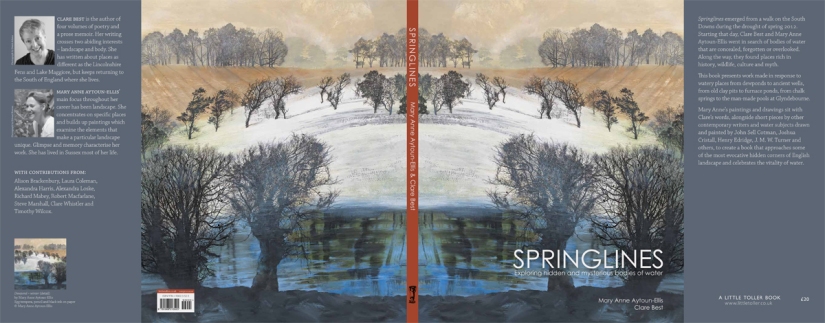A close and exacting collaborative investigation, Springlines reminds us of the value of art-as-inquiry, how paying attention to an object without pre-condition – ‘a perfectly useless concentration’ as Elizabeth Bishop put it – yields what we need to know about that object… This is a book that is serious in its intent and serene in its execution – the result of a powerful communion between poet and artist. Kay Syrad in The Frogmore Papers
An exquisite production – Aytoun-Ellis’s paintings of copses, ponds, snowy hills, and winter trees giving a feeling of austere sumptuousness to Best’s spare and exact poems. John O’Donoghue in Viva Brighton
Alongside Mary Anne Aytoun-Ellis’ haunting depictions of pools and the South Downs, Clare Best’s poems echo and create their own Other atmosphere. Her work combines glorious nature poetry with depth, insight and surprises – the mythic, playful ‘all awake Jack’, or the ‘cubicles of unclipped yew’ at Glyndebourne, where swimmers slip into ‘velvet water’. Familiar landscapes are distilled to their rich essence and we see anew: ‘All the boundaries of the field lean in’; ‘This place knows the weight of what has been’; ‘a dent in the ancient Downs’. Charlotte Gann
A mesmerising book… Country Life
A lyrical pathway through secretly observed places. Annie Jeffery

Springlines, Little Toller Books (April 2017), price £20.
Clare Best and painter Mary Anne Aytoun-Ellis explore hidden and mysterious bodies of water across the south country of England. Read more about the project here.
In this book, their work is set alongside short pieces by other contemporary writers (including Alexandra Harris, Richard Mabey and Robert Macfarlane) and water subjects painted by John Sell Cotman, Joshua Cristall, Henry Edridge, JMW Turner and others.
Lark Walk, February
All the boundaries of the field lean in –
tangled hawthorn, lines of listing trees.
A dropped gate, off its hinges, rests against
slack wire at the join of path and track.
Tufts of caught wool flicker on the wind.
Even the uneven ground leans in, pressing
into air that presses down.
All the boundaries of the field lean in
until the field becomes the world
contained within this place of chalk
and green, while here and there, larks go up –
five, six – rising far enough to start a song,
then sink, to stay on winter ground.
It is not spring, it is not time.
A field above Southover aquifer
50º 51′ 48″ N 0º 01′ 07″ W
